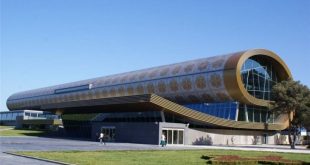In this period Azerbaijan culture developed in the condition of feudal strife and fought against foreign invaders. The turn of Azerbaijan into an arena of permanent wars caused to the destruction of architectural monuments and to the death of cultural figures. Simultaneously, there began prosper of cultural development at this time.
The capitals of khanates were not only the centre of craft, trade but also the culture. There were schools, where studied the children in all cities. The lessons were mostly conducted in Persian and Arabic languages. Along with shariat, there were taught secular sciences too.
The graduaters of these schools were called mirza. They took the post in offices or entered to the line of clergy – became religious figures. Along with schools, which gave junior education, there existed medreses, which study equaled to high education.
At the result of the formation of khanates, the demand to high- educated men became the reason to the certain development of enlightenment.
Despite of hard circumstances in 18th century, science was developing. In the first half of this century there was written the tractate of “Khanadane Sefevi” in Azerbaijan language. There was talked about the creation of Safavids state.
In this period Molla Muhammed al-Cari composed “Cronicle of Car in 18th century”, in which was reflected the fought of Carians against Nadir Shah.
There were composed works in the sphere of geography. Well- known geographer, Haji Zeynalabdin Shirvani travelled to the countries of the East and described them in his works.
Poets of this time created qoshma, bayati and etc. in new janres, along with the continuance of Fuzuli’s traditions. Among the poets, who lived and created in the period of khanates we can mention the names of Nicat Shirvani, Shakir Shirvani, Arif Shirvani, Arif Tabrizi, Agha Mesih Shirvani, Khasta Kasim, Shekili Naib and others. There were reflected the historical events in the works of these authors too. For example, poet Naib, who lived in Sheki in the period of Haji Chelebi described the struggle of nation against Iranian yoke. Shakir Shirvani described the destruction of Shirvan uprising by Nadir Shah in 1743, in his work called “The History of Shirvan”.
Most prominent poets of the 18th century, were Molla Veli Vidadi (1709-1809) and Molla Penah Vaqif (1717-1797), who made close the poetry to nation in their works, written in simple national language.
Vidadi was born in Shamkir, lived in Karabakh and then in the palace of Georgian tsar, Irakly II. He was a great master of goshma. The poems of Vidadi, such as “Vaqif”, “Chokdandir”, “Aghlarsan” possessed special essence.
There were reflected line of historical events and were created the icon of many statesmen in high level in the poema of “Musibetname” of Vidadi.
Vaqif was born in the village of Qiraq-Salahli of Kazakh region. In 1759, he came from Kazakh to Karabakh. In 1759, he was inclined to the palace and lived in Shusha till the end of his life. Vaqif served as prime vezir of Ibrahimkhalil khan and played special role in the governance of Karabakh khanate.
Leading theme in the creature of Vaqif was love lyrics. The respect and influence, which possessed Vaqif shaped a proverb in Karabakh as: “Not each singer could be Molla Penah”. Vaqif, who created beautiful, simple, realist and secular poetic icons of heros of his works, stepped from the type of classic romantism to realism, determined the future literature direction.
In 18th century, there had been copying the books by hand in Azerbaijan and they were decorated by miniatures and various scenes. The library of Sheikh Sefi in Ardebil possessed world fame. This library was brought to Sankt-Petersburg when Ardebil was conquered by Russian troops in 1828.
Music, architecture and art reached to new level in 18th century.
As, before, an art of mugham possessed special fame at this time: tesnifs were also included to mughams.
In 18th century, although the feudal strife and military hostilities stopped the development of construction in cities, it did not concerned to the built of residences of khans and common buildings. There were created significant monuments of architecture, to which we can concern the Goy-mesjid in Iravan that was built in 1760 and the palace of Sheki khans in Sheki, which was built by Haji Zeynalabdin Shirazi in 1762. This constructions, as well as the house of Shekikhanovs, Juma Mosque, “Gileyli” mosque in Sheki were decorated by rich and different theme. Drawings and styled view of people and animals, which were drawn with bright colours, multifigured compositions-the scenes of wars and hunting-substitutes one another in interior halls of the palace.
Naturally, there were not essential changes in the development and design of structure of Azerbaijan cities in this period, which showed that in which level the architecture and urban construction in Azerbaijan developed. This was obvious especially in the architecture of houses.
Major part of the territory of cities were divided into mahallas. This division was related with socio-economic causes. There were bathes, mosques, water-drilling constructions, gardens, parks (green massive) in cities too. Such gardens were located in Tabriz, Shamakha, Ganja, Ardebil and Nakhichevan.
Water-drilling construction of the city were located in the highest level. This was the system of arkhs and kargiz canals, which were located in Tabriz, Ardebil, Ganja, Shamakha and Baku.
There were constructed Shusha, Askeran and Bayat castles, Shusha mosque in Karabakh. All above-mentioned monuments were the beautiful samples of architectural and decorative art of Azerbaijan. Generally, the culture of the 18th century took essential place in the development of centuries-old national culture of Azerbaijan.
 Oval Useful news from Azerbaijan and Caucasus
Oval Useful news from Azerbaijan and Caucasus
